Blue Bolt Shrimp is one of the most popular freshwaters in the aquarium trade. Aquarists prefer these invertebrates not only for their spectacular color but also for their cleaning ability. Although they are very attractive, they are challenging to care for.
So, let’s find out if this species is the right choice for your aquarium.
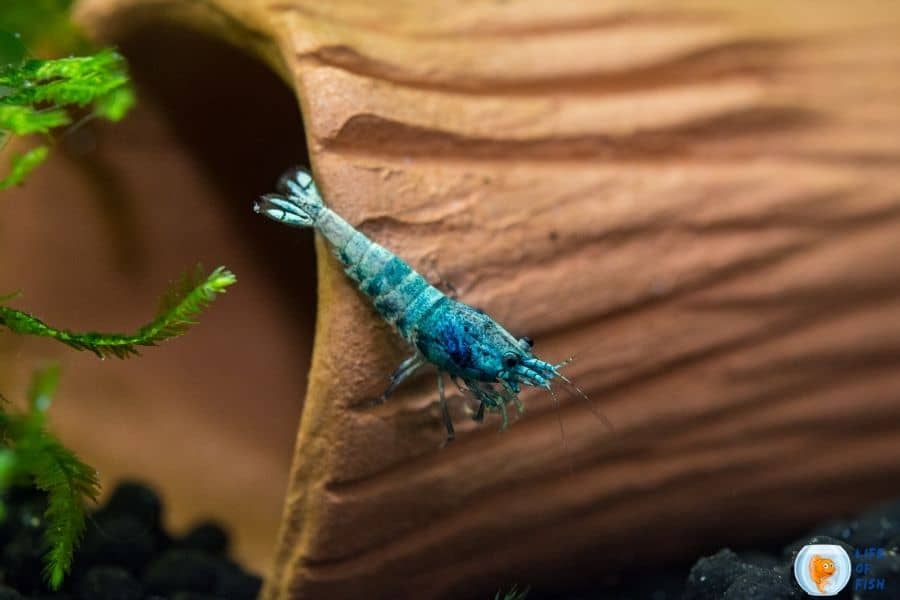
What is blue bolt shrimp?
Jump To
Scientifically named Caridina cantonensis, Blue bolt shrimp is a Taiwan bee shrimp variety. It is a mutation of crystal red, crystal black, and golden bee shrimp.
How big do blue bolt shrimp get?
Blue bolt shrimp is a small-sized shrimp that grows up to 1.25 inches (3cm) long. As this is a small shrimp, you can even keep him in a small tank of about 5 gallons.
But, as this is a sensitive shrimp species, it needs to have excellent water conditions inside the tank to survive.
Is blue bolt shrimp aggressive?
No. they are non-aggressive shrimp species. They are completely harmless and do not bother any other fish or shrimp in the tank.
They like to stay as a group and have no dominant male or female, making them non-territorial.
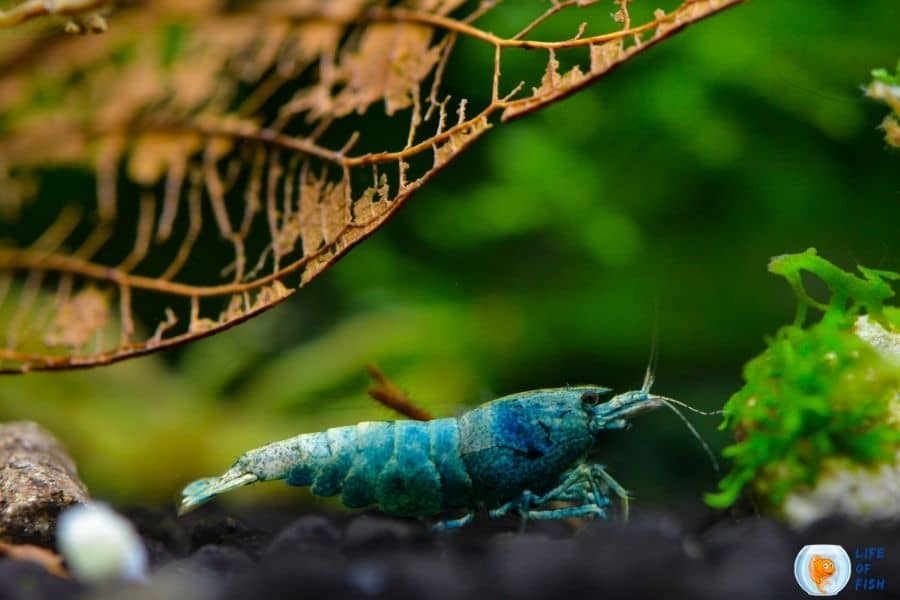
Blue bolt shrimp behavior
They have fascinating behavior. Unlike other non-aggressive shrimp species, blue bolt shrimp are not shy.
They are very active during the daytime, scavenging and cleaning up the tank. Although they are active shrimp species, there is no harm from them to other aquatic species as they don’t bother anybody in the tank.
Blue bolt shrimps are not territorial species. Instead, they are very social and tend to gather in large groups.
This could be due to the shrimps’ small size and low defensive capability. They seem to be more relaxed and confident when they stay in groups.
Although they aggregate in groups, they lack social structure. Blue bolt shrimps don’t have any dominant male or a female.
Although these fish are tiny, they are very agile and can move very fast. The shrimps can move around 15 – 20 cm (6 to 8 inches ) distance in a blink of an eye.
Lifespan:
Like any other small-sized shrimp species, they live only about 1 to 2 years at maximum.
However, many blue bolt shrimps die sooner because of poor water conditions and other diseases.
Blue bolt shrimp care
They are challenging to care for. Their requirements are somehow tricky for beginners.
But, if you have some experience in caring for any other shrimp, you can keep these shrimp with a little more Care.
Blue bolt shrimp size
They reach about 0.75 – 1.25 inches in length and live for about 1 to 2 years maximum. They are a small shrimp species, just like golden bee shrimp.
Blue bolt shrimp tank size
The recommended tank size for them is 10 gallons. However, if you frequently change the water and keep the water parameters at optimum levels, you can keep this shrimp even in a 2-gallon tank.
How many blue bolt shrimp should be kept together?
Blue bolt shrimps prefer to live with groups. Therefore it is recommended to keep at least six shrimps together.
Otherwise, the shrimp can become shy. However, if you intend to keep a group of blue bolt shrimps, be sure to provide at least a 10-gallon tank.
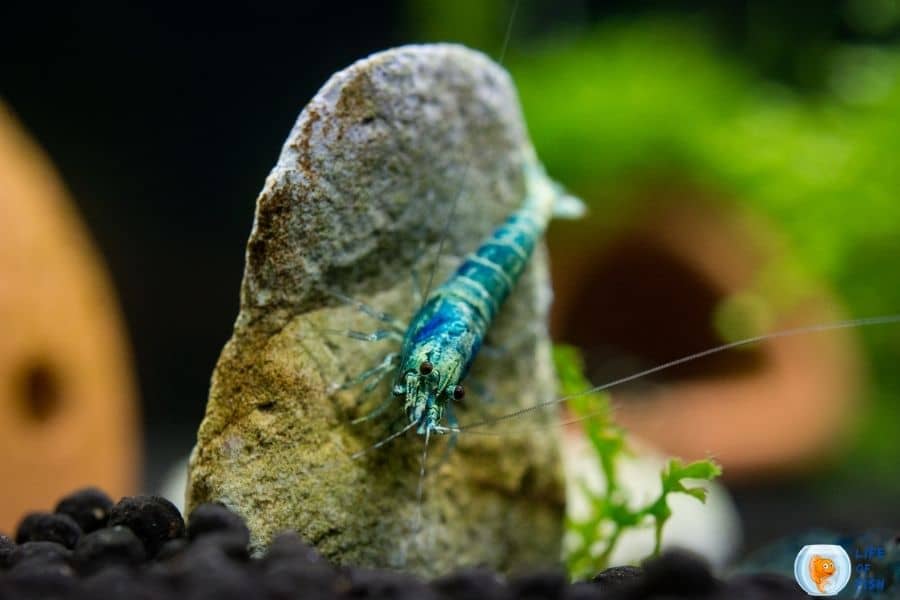
Tank setup
The blue color morph of Caridina cantonensis is a captive-bred species. So, it is impossible to find them in the wild. Therefore, it isn’t easy to guess their preferred habitats.
However, wild Caridina cantonensis can be found in Southern China, widespread and abundant.
These wild species prefer shallow, slow- to fast-moving mountain streams and creeks. So, it is better to provide a surrounding similar to these habitats in your aquarium.
They are extremely sensitive species. So, you need to provide excellent quality water for these shrimps.
Never use tap water with blue bolt shrimps. We recommend using only Ro/DI water with blue bolt shrimps. Be sure to add some remineralizes before adding your shrimp to the tank.
Substrate
Blue bolt shrimps prefer low pH levels. So, you will have to use active substrates like ADA Amazonia aqua soil, Fluval Plant and Shrimp Stratum, and Akadama-Bonsai soil as the substrate.
Active substrates can lower the pH level of the water. Therefore, it is beneficial to use active substrate in your aquarium.
Filters
Clean water is a MUST for them. Therefore, you MUST install a high-quality water filter in your aquarium. They can not survive in poor water conditions.
Aeration
The wild Caridina cantonensis habitats contain good aeration as they live in mountain streams and creeks.
Therefore, it is recommended to provide good aeration in the shrimp aquarium. For this, you can add an air pump to the aquarium.
Lights
Bue bolt shrimps don’t have any specific lighting requirements. So, you can provide lighting as you prefer.
Keep in mind that if you intend to grow plants in your aquarium, you have to provide proper lighting.
Decorations and Plants
Decorations and plants are not necessary for blue bolt shrimps as they are captive-bred species.
However, adding some driftwood and plants will not hurt as it provides them some places to hide when needed.
And also, having live plants in your aquarium is beneficial in case of a power failure. Plants can provide natural filtration and enough oxygen for your shrimp to survive until the power comes back.
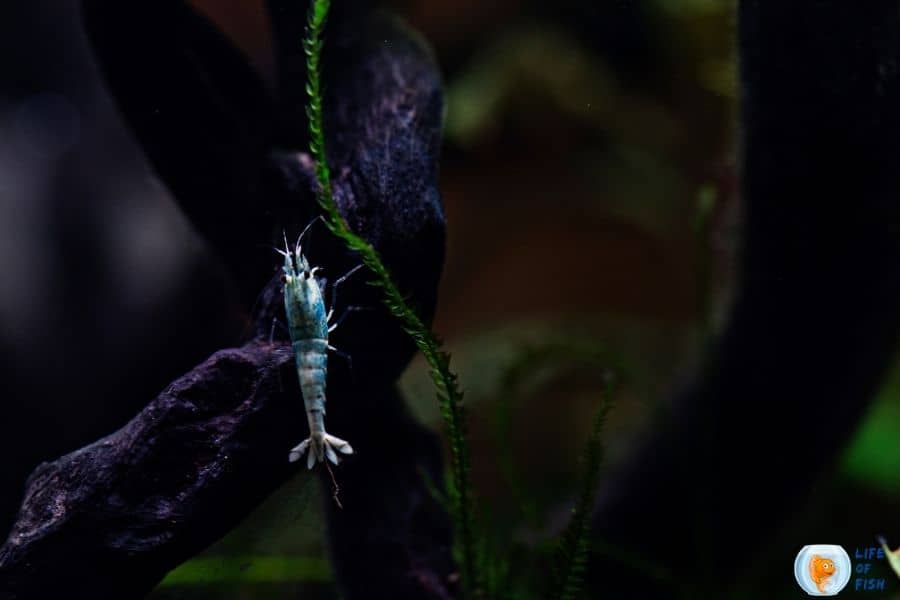
Water quality condition
They are extremely sensitive species to water quality changes. Even a tiny change in water parameters can kill this creature very fast.
Therefore, keeping the highest quality water in your tank and checking the water parameters frequently is necessary.
Temperature– They can tolerate a wide range of water temperatures. However, they thrive in cool water temperatures. The optimum water temperature for these species is about 20 – 22 °C (68-72 °F).
pH Level– Blue Bolt Shrimps prefer low pH levels in the water. The optimum pH level is 6.0 – 6.8.
Hardness– They appreciate soft water. The hardness of the water should be KH 0 – 2 and 3 – 6 GH.
TDS– The TDS(total dissolved solids) level of water should be 100-150.
Ammonia and nitrite level should always be zero. These shrimps can tolerate nitrate levels up to 25ppm.
Blue bolt shrimp male or female identification (blue bolt shrimp male vs. female)
Identifying them is somewhat hard until they mature.
Matured female shrimp have a slightly larger tail and have a “saddle” formation on the upper body, behind the head, where eggs are stored before fertilization.
Once they are “buried,” this shape will be more prominent. Fully-grown male shrimp are always smaller than fully-grown female shrimp.
Identify pregnant blue bolt shrimp and pregnancy stages
When they are pregnant, their abdomen gets larger, and their saddle shape becomes more prominent.
A pregnant shrimp is called a berried shrimp. Shrimps become sexually mature when they are about 3 to 4 months old.
Blue bolt shrimp breeding
Male Blue bolt shrimps are not aggressive breeders. They may not spawn if they feel threatened or don’t have places to hide.
So, breeding blue bolt shrimp is not as easy as other shrimp.
When the water parameters are in order, and your shrimps are well-fed, the female shrimps will be “buried” once they mature.
And, When they are ready to mate, the berried shrimp molts. They also release a particular chemical to attract males. This chemical signals the male to find the berried female, and it will swim around the tank to find the female.
Once they meet, they immediately start to spawn. These shrimps reproduce via internal fertilization.
The female shrimp carry a clutch of eggs under their tails, and males fertilize them. The incubation period of these fertilized eggs is around 4 to 5 weeks.
During this time, the female shrimp fan the eggs regularly with its pleopods to provide enough oxygen to the eggs.
After the incubation period, the female shrimp releases up to 30 to 40 fully developed shrimplets that are about 2mm long.
The breeding of blue bolt shrimp should be done only in a fully established fish tank because the fry can only survive when there is enough biofilm available. Shrimplets can only feed on biofilm in the first days of their life.
How many babies do blue bolt shrimp have?
Female blue bolt shrimp release about 30 to 40 babies at a time. However, this amount may depend on the size of the female shrimp.
Blue bolt shrimp fry care
Blue bolt shrimplets must have a biofilm in the fish tank in their first few days of life.
Shrimplets can not feed on any other food as they are so tiny, about 2mm long. When they slowly grow, they will slowly start to feed on shrimp food eventually.
Special tips
Be careful when using medications in a shrimp tank, as most fish medications are toxic to shrimps. In Particular, you shouldn’t use any chemical containing copper in a shrimp tank.
Blue bolt shrimps are delicate shrimp species. So, when you do any water changes, you should do it carefully without changing water parameters at extreme levels.
Always use RO/DI water in the shrimp tank to be on the safe side.
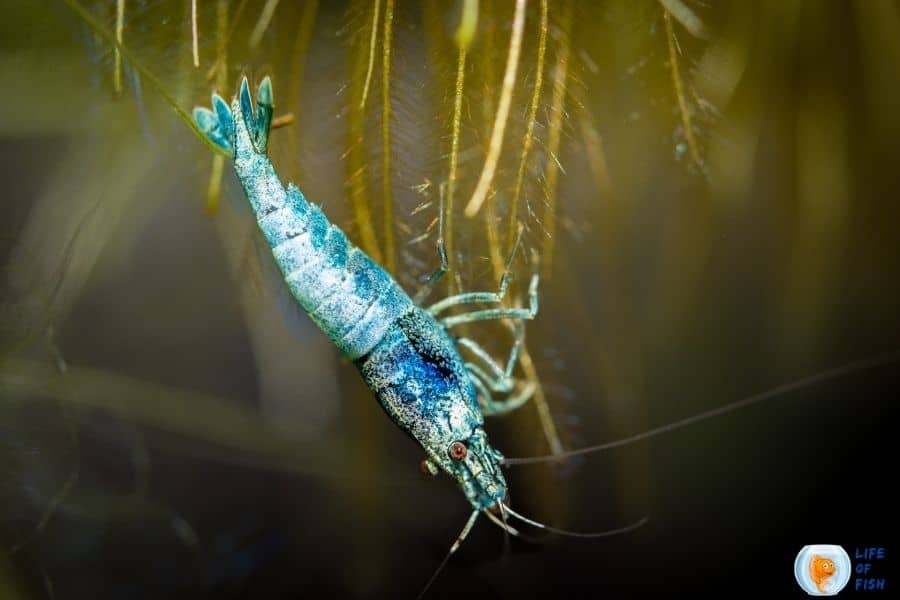
How to feed blue bolt shrimp?
Feed your blue bolt shrimp just once per day (or once in 2 to 3 days if you have an established tank) to motivate them to clean your aquarium.
They get enough food to thrive in the biofilm of your tank.
When you feed these creatures, you should allow up to 6 hours for them to consume the food.
After this time frame, remove any excess food to prevent overfeeding and fouling the water. You can also use feeding dishes to feed blue bolt shrimps to avoid any potential mess.
What fish can live with blue bolt shrimp?
Blue bolt shrimps are peaceful shrimp species. Hence, you have to choose equally quiet, peaceful creatures for these shrimps.
The tank mates also should be able to live with the same water parameters as blue bolt shrimps.
Blue bolt shrimps are compatible with shrimps and snails such as,
- Crystal shrimp
- Bee shrimp
- Bamboo shrimp
- Caridina cf. babaulti
- Tangerine Tiger Shrimp
- Japanese trapdoor snails
- Ramshorn snails
- Nerite snails
- Malaysian Trumpet snails
- Black Devil Snails
You should avoid large and aggressive fish species. And also, keep these shrimps away from all types of crayfish and crabs.
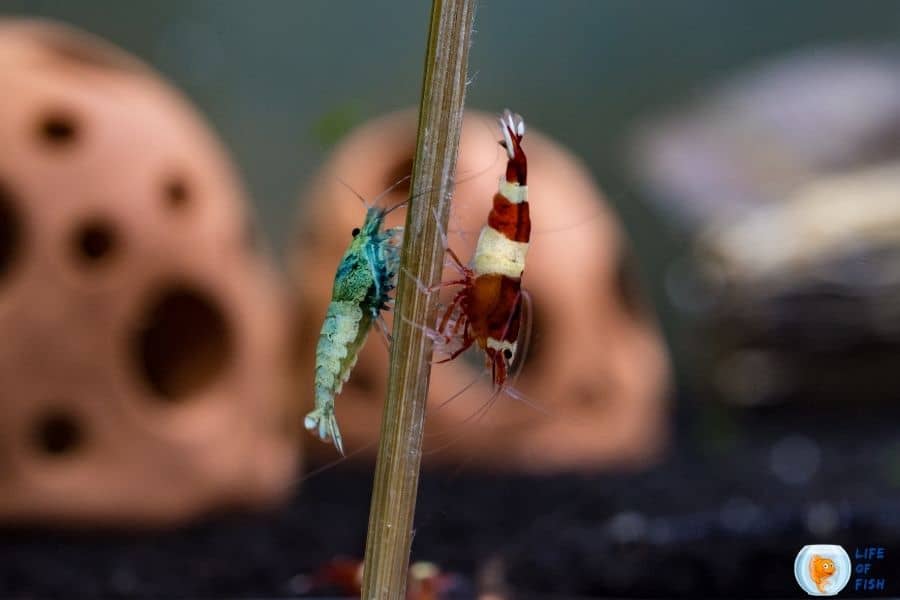
Related Questions
Are blue bolt shrimp hard to keep?
Blue bolt shrimps are challenging to care for shrimp species in the aquarium trade.
Therefore, only experienced aquarists choose to raise these shrimps in their aquariums. As these are fragile shrimp species, even one mistake can kill the shrimp.
So, you have to be extra careful when taking Care of blue bolt shrimps.
Can blue bolt shrimp live with cherry shrimp?
Yes. You can keep both shrimp species together as both species are peaceful.
But, only one species will thrive and breed. And, the other will not. But, this happened according to the water conditions you provide.
Are blue bolts Neocaridina?
No. Blue bolt shrimps are a Caridina shrimp species.
Caridina and Neocaridina are different types. But, both shrimp types have fairly similar water parameter needs and can coexist well.
Where do blue bolt shrimp come from?
Blue bolt shrimp is a “mischling” or a crossbreed.
So, there is technically no origin for these species. However, experts believe the origin of this breed is Southern China.
One look Care guide
| Scientific name | Caridina cf cantonensis var. ‘Blue bolt’ |
| Common name | Blue bolt shrimp, Taiwan bee, extreme blue bolt |
| Care level | Moderate to Difficult |
| Native to | Southern China |
| Type | Shrimp |
| Color | Blue |
| Tank size | 2-gallon minimum, 10-gallon recommended |
| Preferred temperature | 20 – 22 °C (68-72 °F) |
| Other water parameters (ammonia ,ect) | pH 6.0 – 6.8 , 3 – 6GH, 0 – 2KH, 100-150 TDS, 0 Ammonia, 0 Nitrite, 25ppm Nitrate |
| Preferred salinity | No salinity |
| Size of the Blue Bolt Shrimp | 2.5 – 3 cm (1 – 1,25 inches) |
| Life Span | 1-2 years |
| Temperament | Peaceful Non-aggressive |
| Recommended tank mates | Shrimps, and Snails, No large and aggressive fish, No crayfish or crabs |
| Preferred food | Biofilm, Fish flakes, pellets |
| Feeding frequency | Once per day or once per 2 to 3 days |
| Breeding | Medium (a high order shrimp). |
Read Next: Red Coris Wrasse (Coris gaimard) Ultimate Care Guide
